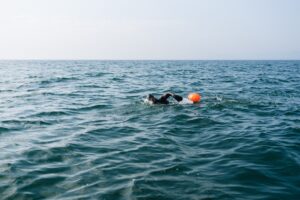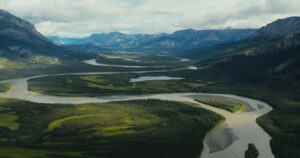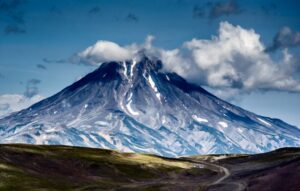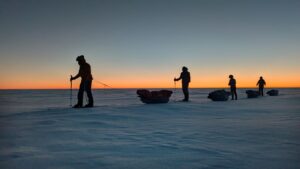Thirty-five years ago, during the Cold War, American endurance swimmer and citizen diplomat Lynne Cox swam from the U.S. to the Soviet Union. She did so across the frigid Bering Strait, wearing just a swimsuit, a bathing cap, and goggles. Once she reached the slippery rocks of the Soviet Big Diomede Island, some two hours and six minutes after her departure from Little Diomede Island in the U.S., the Cold War was pronounced over.
Big and Little Diomede

In late July 1987, I flew over the Ural Mountains, which cross Russia from the Arctic Ocean to Central Asia, over Siberia’s endless taiga and tundra, to Chukotka. Underneath, sapphire lakes alternated with mountain ranges and rivers flowing north. It was a familiar landscape and a route that I had traveled many times as a polar correspondent for Pravda.
But this time, I was not sure I would reach my final destination at all. I was flying to a place I have never been before, a forbidden island lying in the middle of the Bering Strait. “Tomorrow Island”, or Ostrov Ratmanova as it was known in the Soviet Union, was closed to most since the early 1920s, some five years after the Communist Revolution.
Once upon a time, this rocky island was the home of a thriving Inupiat community. They moved freely across the strait between Chukotka and Alaska, following the animals. For millennia, the island had a beautiful name, Imaqliq, which means “surrounded by water”. It was facing Inaliq (which in the Inupiaq language means “the one over there”, or “the cliff”), now known as Little Diomede. Little Diomede lies three kilometres and one calendar day away, in U.S. territory.
Now Imaqliq/Big Diomede/Ostrov Ratmanova was a top-secret Soviet military base, filled with soldiers, radar, and who knows what else.
Soon after WWII, the proud Inupiat were kicked out of their sacred home on Imaqlik and forcibly relocated to Chukotka’s mainland, into Soviet-style reservations. With the arrival of the Ice Curtain in 1948, much less known to the world than the Berlin Wall, families living across the strait were separated. Travel across the strait came to an end. Brothers could not see their sisters, young children would never meet their grandfathers.
The Californian poet crisis
While approaching Chukotka, I was thinking of a young man, whom I now know well and love. At that time in the Soviet Union, he was more a fairy-tale personage than a real person. In 1965, at the age of 19, he managed to cross the Bering Strait on foot, from Little Diomede to Big Diomede, almost starting WWIII in the process.
His name was Dennis Schmitt. A young Berkley graduate, a poet, mathematician, linguist, philosopher, and musician from California, Dennis Schmitt walked over the frozen strait undetected by Soviet radar. When he reached the shore, locals took him for a ghost; but soon they were so happy to meet an Inuk, a “real human” arriving from the other side. They fought about who would be the lucky one to take the stranger into their home. Dennis Schmidt stayed with his hosts for a couple of days, until the KGB arrested him.
A couple of days later, once news that an American had been captured by the Soviets reached the CIA, military helicopters landed on Little Diomede. In response, Soviet military ships arrived at Big Diomede.
Luckily for Dennis Schmidt, the crisis was resolved diplomatically, and the young poet was sent back to Little Diomede to be thoroughly interrogated by the CIA as a potential Soviet spy.
Enter Lynne Cox
Now, 22 years later, another person from sunny California was about to cross the Strait without a permit. Lynne Cox, a 30-year-old marathon swimmer known for her cold-water abilities, was going to swim from Little Diomede to Big Diomede with a grandiose mission to thaw the Ice Curtain and finish the Cold War.
There were many similarities between the two journeys, but of course, things had changed since 1965. Then, Dennis Schmitt could easily have been shot or vanished into a Siberian GULAG. Certainly, he stayed alive by pure luck. In 1987, with the arrival of Gorbachev’s glasnost and perestroika, Lynne Cox was less likely to receive a bullet.
Cox confronted strong currents, freezing temperatures, sharp reefs, hungry polar bears, and jellyfish. But the hardest obstacle now was not natural. It was ugly politics.
She spent 11 years trying to obtain a permit for her swim across the Bering Strait. Cox wrote to General Secretaries Brezhnev, Chernenko, Andropov, and finally to Gorbachev. There was no response.
The biggest hurdle: bureaucracy
Then came hope. After contacting many U.S. senators, who simply would not believe that this project was either doable or necessary, Alaskan Senator Frank Murkowski was suddenly inspired by Cox’s idea. He contacted the Soviet Ambassador to the U.S., Anatoly Dobrynin, an unorthodox diplomat. He was suddenly inspired too. Dobrynin sent a supportive telegram to Eduard Shevarnadze, the Soviet Minister of Foreign Affairs, and –- most importantly –- to Alexander Yakovlev, the “godfather of glasnost” and the intellectual force behind Mikhail Gorbachev’s reforms. Months passed and encouraging messages were exchanged, but the official permit never materialized.
There was no official permit, no real sponsors, and no support, except her family and friends. But Cox decided to go forward no matter what. She used every last penny of her savings to realize her swim.
When she arrived on Little Diomede, locals looked at her with amusement. Most Inupiat, who don’t swim, believe that once you fall through the ice, your chance of survival in the freezing water is slim. To swim a couple of miles from one island to another seemed like madness or suicide.
Could it be done?
Not only the Inupiat thought Cox’s swim impossible. Most Soviet scientists and medical doctors studying hypothermia, whom I interviewed before my flight to Big Diomede, agreed: Either Cox’s body or her mind would collapse in the extreme cold. They were arguing which would happen first.
They projected that by the midpoint of her journey, her body temperature would fall to 32°C. Nobody, even those who were praying for peace between the U.S. and the Soviet Union, believed that Cox would make it.
I reached Big Diomede Island two days before her swim. At night, a small gathering of adventurous Soviet reporters and athletes toasted the occasion, but almost everyone shared the same doubts.
One athlete familiar with Cox’s previous swims across the English Channel said that, “She may make it because she is more like a seal than a woman.” According to this gentleman, an “abnormal amount of subcutaneous fat creates a sort of a wetsuit, or a seal skin, and thus makes the body resistant to the extreme cold.”
A Soviet colonel present at the table suggested that Cox might cover her body with a layer of walrus fat (quite an insane idea for swimming a strait filled with polar bears). Others speculated that Cox would use some secret American warming batteries. The crowd argued where these batteries would be hidden.
But despite the disbelief, the frigid air of Big Diomede was filled with excitement and hope. Everyone knew that something grand was about to happen.
And then, exactly 24 hours before the start, the official permit finally arrived from the Kremlin.
Tomorrow Island
The next morning, we were standing on the rocky shore of Big Diomede, or Tomorrow Island. Reporters, athletes, special services, military staff, diplomats, and politicians all peered into the fog.
When the permit arrived only 24 hours before the swim, rumor was that the Inupiat guides commissioned to lead Cox across the Strait were so happy that they had a night-long celebration. For the first time in 48 years, they would see some of their relatives.

Cox swimming the icy Bering Strait. Photo: Wolverine Camera
When they woke up, the morning sun had disappeared. A thick fog called naternaaq (low fog, as opposed to kipisimaq, high fog) fell onto the water. The umiaqs (boats made out of walrus skin) lacked navigation equipment. They only had an old rusty compass. The other problem was that none of the young guides had ever been to Big Diomede themselves.
With 400m of visibility, Cox was afraid that she would miss the island, which was rather small despite its name. She also felt the temperature drop to 5˚C. Her arms were turning gray, “the color of a cadaver”, in her own words.
But stroke after stroke, she crossed the International Date Line. In less than an hour and a half, from August 6 on Little Diomede Island, she arrived into tomorrow, August 7.
An extra 800m
The fog was getting denser, and Big Diomede was nowhere to be seen. Suddenly, Cox heard a boat engine somewhere nearby. The Soviet support vessel, sent to lead the way to Big Diomede, had discovered her and her team.
A Soviet translator on the boat informed Cox that a big welcoming party of journalists and others was waiting for her on the shore, 800m further than Cox had planned. She had to make a tough decision on the spot: to get out of the water on the closest shore or swim an extra 800m to meet the people.
She decided to do the 800m extra. “I felt like if I touched a rock instead of someone’s hand, what have I done? Nothing,” she recalled later. The last 800m were the hardest.

After an extra 800m, Lynne Cox lands on Big Diomede Island. Photo: Lynne Cox
When we finally saw Lynne in the water, we started jumping, screaming, crying, and hugging each other. Finally, after almost 50 years, the border was open again.
Lynne was so exhausted that she could not pull herself up onto the sharp rocks, and a few military guys had to help her. Then it was time for the doctors to take her away from us for some time.
Reverberations from the swim
Later that year, President Gorbachev traveled to Washington to sign the Intermediate Range Nuclear Forces treaty. President Reagan raised a glass to toast the swimmer. And then Mikhail Gorbachev said something unimaginable for the Soviet leader:
“Last summer, it took one brave American by the name of Lynne Cox just two hours to swim from one of our countries to the other. We saw on television how sincere and friendly the meeting was between our people and the Americans when she stepped onto the Soviet shore. She proved by her courage how close to each other our peoples live.”
After Lynne Cox’s swim, the indigenous people from Alaska and Chukotka were finally granted the right to see each other. The Ice Curtain had started to melt.
That’s how Lynne Cox became the biggest citizen diplomat of our times.

Lynne Cox, right, reunites 35 years after her swim with writer Galya Morrell.
Reunion
Two weeks ago, I met Lynne again, 35 years later after our first meeting on Big Diomede. We both cried. I told Lynne that her swim in 1987 changed lives of many people, including my own. On that day, I understood that one can overcome extraordinary obstacles by taking risks, and that the human body and mind, so vulnerable, can perform miracles, if there is a will.
Today, everything that Lynne built in the Bering Strait in 1987 has fallen apart.
We are in the fog again.
Lawrence Khlinovski Rockhill, one of the old-timers who helped to rebuild the sundered connection between American and Russian indigenous peoples in late 1980s, asked me on Facebook after reading my post about Lynne Cox:
“Where are all the Ice Curtain Melters when we need them now? We did it before, and yes, we can do it again!”






